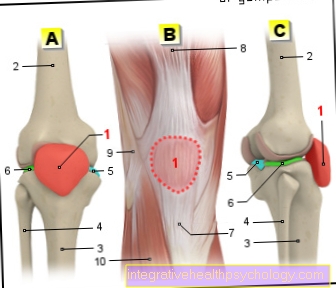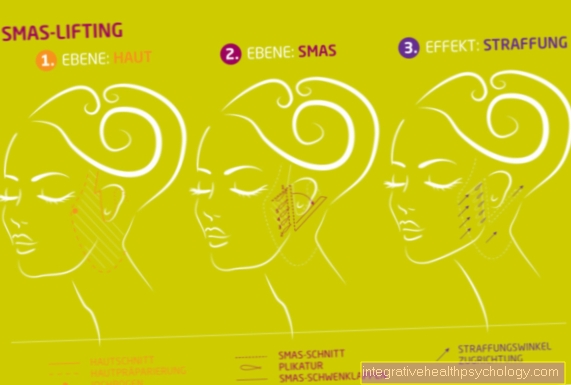Maximum strength
definition
The maximum force as a manifestation of the force is defined as the force that the nerve-muscle system can exert when the muscles contract voluntarily.
In the past, the manifestations of maximum strength, speed strength, reactive strength and strength endurance were below strength. Today, maximum strength is the overriding form of rapid strength, strength endurance and reactive strength.
Areas of application
As already mentioned above, the maximum strength represents the basis for further strength skills. The training of the maximum strength therefore has a high value in the training practice and is considered the basis of many physical requirements.

Differences to the absolute force
The absolute force, on the other hand, is calculated from the Maximum strength and the autonomously protected reserves.
The maximum force is therefore the force that a person arbitrarily releases during training and competition.
The autonomously protected reserves are only released under certain circumstances. These circumstances can be:
- under Fear of death
- By Electrical stimulation
- Medication (abuse) / doping
Differences in absolute force
The amount of the autonomously protected reserves changes depending on the level of performance. With increasing performance, the proportion of the autonomously protected reserves in the absolute force decreases.
Structural breakdown of the maximum strength
The maximum strength consists of the muscle quantity (number of muscle fibers), the muscle quality (fiber distribution) and the ability to be activated at will.
Types of maximum strength
there are different manifestations of maximum strength:
- dynamic- concentric maximum force (with overcoming work)
- isometric maximum strength (holding maximum force)
- dynamic- eccentric maximum force (yielding maximum force)
How can you improve your maximum strength?
Maximum strength training is very popular in the fitness and bodybuilding industries. But athletes, especially beginners, do not always know how to train and improve their maximum strength. A good way to improve maximum strength is through the repetition method. This method works with high loads (more than 80% of the 1RM) and aims to regenerate almost completely during the rest breaks. The breaks are therefore longer than with other training methods. There is a pause of up to five minutes between the individual sets so that the body can recover. Typically, the rep method is done for five to eight reps in three to four sets. Due to the long breaks in sentences, the athletes must make sure that the muscles do not get cold, otherwise training injuries can occur.
Another variant of maximum strength training is pyramid or Christmas tree training. You start with a relatively low weight and perform up to twelve repetitions. Now in the next set the weight is increased and the number of repetitions is decreased by two to three. Then the weight increases again a little and the number of repetitions decreases again. This procedure continues until you get to two or one repetition. If you are fit and still have strength, you can train the pyramid or the Christmas tree backwards and increase the repetitions and reduce the weight.
Typical exercises to improve maximum strength
Exercises that are often used for classic maximum strength training are:
- Squats
- Bench press
- Lat pulldown
- Deadlift
- Leg press
- Pull-ups
The lat pulldown and leg press are beginner exercises that are recommended at the beginning. The advantage is that by training in the machine, the risk of injury is lower than with a workout with free weights.
With the leg press, you sit or lie on a chair and try to push a weight away with your legs. This stresses the entire leg, buttocks and parts of the lower back muscles.
When pulling down, you sit on a stool and pull a weight down towards you, which is hanging over your head by a cable pull. The pulling down is as explosive as possible and the upward movement is slow and controlled.
Exercises that are better suited for advanced athletes are the bench press, the squat and the pull-up. Here, the muscles not only have to overcome the weights, but also absorb movements in all three dimensions.
2 methods of maximum strength training
A key question is how the maximum strength is trained in everyday training.
Training science developed 2 methods for maximum strength training:
- Method of repeated use of force (Hypertrophy training)
- Stimulus intensity: 40 - 60%
- Repetitions: 10 - 12
- Break: 2 - 3 minutes
- Movement speed: slow to brisk
- Method of maximum effort (IK - Intramuscular Coordination)
- Stimulus intensity: 90 - 100%
- Repetitions: 1 - 5
- Break length: 3 - 5 minutes
- Movement speed: explosive
For more information on this topic, see: Maximum strength training
How quickly can you improve your maximum strength?
When training maximum strength, it takes time for the body to react and to start building new muscle cells to the high loads. After just two weeks you will feel an increase in strength and the muscles can already handle higher weights. A good increase in maximum strength, accompanied by an increase in muscle mass, occurs within four weeks. Success can already be seen after three months.
However, one should keep in mind that bones, tendons and ligaments also react to the new stresses with adaptation processes. This happens much more slowly than with the muscles. For this reason, the weights should not be increased too quickly over and over again, as otherwise injuries to the tendons and ligaments can occur.
How much can you improve your maximum strength?
Both maximum strength and endurance can be trained very well. If you look at top-class sport, then especially with maximum strength in the deadlift, e.g. half a ton (500 kg) emotional. That is enormous compared to a person who is not exercising. If you assume that a beginner can deadlift 50 kg, this is an increase of 1000% of maximum strength up to 500 kg.
However, the rate of increase in maximum strength depends on several factors. On the one hand, the athlete / athlete plays an important role as every body functions differently. On the other hand, it also depends on how far the speed strength, strength endurance and reactive strength are trained.
What is the maximum strength calculator?
The maximum strength calculator helps beginners and advanced users to optimize training control. It determines the so-called "one repitition maximum" (1RM). The maximum weight that the athlete can overcome in one repetition is determined. There are many ways to determine this weight today. As an athlete, you always find it interesting to know how strong you are and what weight you can gain.
However, it is also important to know how high the 1RM is for other reasons. It can help to control training in general. The weight specifications are often not expressed in kg, but as a percentage of the 1RM.This makes the training plan more individual and you train more effectively. In addition, the maximum strength calculator helps to maintain motivation. If you keep inserting a 1RM test and documenting the small progress made, you remain more motivated during training.
What is maximum strength training?
Maximum strength training is a form of training that focuses on building muscles and increasing strength. The focus here is particularly on improving maximum strength.
A distinction is made between maximum strength training and maximum and sub-maximum training. The submaximal training serves to improve intramuscular coordination, and the muscle cells work together more effectively and generate more strength during exertion. In this training, the load is set to a maximum of 80% of the 1RM. But the number of repetitions is also higher than with maximum strength training.
The maximum strength training, on the other hand, moves at 80-100% of the 1RM and is therefore significantly more intense than the submaximal strength training. However, this also automatically reduces the number of repetitions. The breaks in sets are longer in maximum strength training than in submaximal strength training.
Read more about this under: Maximum strength training
How do you do a maximum strength test?
A maximal strength test is typically done for three exercises: bench press, squat, and squat. In theory, you can do a maximum strength test for any strength exercise. However, the question is whether this makes sense for every exercise. Maximum strength tests can also be carried out on devices. There the maximum strength of individual muscles can be determined in order to be able to design the training plan even more individually.
With a classic maximum strength test like the 1RM, it is important that the athlete to be tested has warmed up well. Then start with a weight that the athlete can definitely manage. Then the weight is increased in the same steps and only one repetition is performed. This procedure is carried out until it is no longer possible to repeat it. The last fully completed weight is the 1RM





























